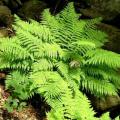The jewel of ferns, Athyrium filix-femina, commonly known as the Lady Fern, is a perfect peridot pop of
clumping color with her fan of feathery foliage. A medium-sized
deciduous fern (about 25 to 30" long and 6 to 9" wide), with stems shifting from chartreuse to red and sunny spring-green leaves arising from a central point, Lady Fern is sought after for her decorative appearance.
Native to most areas of the temperate Northern Hemisphere, Lady Fern enjoys a neutral to slightly acid, well-drained woodland setting with good shade and a damp environment. However, if given enough moisture, she will even tolerate sun.
Lady Ferns will spread to form wonderfully dense clumps making her a brilliant blaze of bright green as a groundcover. She is interesting in that as she grows farther out her center dies away, leaving a ring of lovely, lacey green.
Lady Ferns reproduce by thick, scaly
rhizomes and
spores called sori that grow on the underside of the leaf. Ultimately, when you crave invigorating, illuminating green color and dense coverage coupled with a medium
height, you'll want to consider the Lady Fern; she stands bold and beautiful in a skirt of green that lights up any shade garden.
Interesting Facts Beware, the fronds and the rhizomes of the Lady Fern are poisonous when raw, but
edible after cooking.
Athyrium filix-femina has achieved the Royal Horticultural Society's Award of Garden Merit.
Take the time to cut the fall die back to the ground and apply a fresh layer of mulch.
This will help to protect the fern tubers from popping out of the ground over winter freeze/thaw cycles as well as from squirrels or other critters digging them up for winter food.
Lady Fern is also easily divided every 3-4 years in spring.
Performs best in well-drained (but moist) soil with added organic compost or peat moss. Best not to allow soil to dry out.
Ferns have delicate foliage that often suffers during shipment and transplanting. Cut off any foliage that is broken, bent, brown or yellow - the plants will quickly recuperate with fresh growth. Bare root ferns are particularly prone to foliage loss, it is not uncommon to have to cut them off at ground level when transplanting. As long as the roots are firm they will recover, often showing new growth within weeks during warm months. If transplanting bare root ferns during warm weather they might not send up foliage until summer ends or the following spring (best to transplant bare root ferns when they are dormant: late fall to early spring).
General information that applies to all plants:
-
Ground
preparation, fertilization, pH
-
Planting
instructions
-
Explanation
and description of bare roots
-
How
to plant bare root plants
-
If you
cannot plant bare roots right away
 (0)
(0) Part sun
Part sun  Shade
Shade

